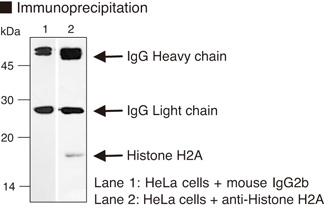This site is for customers in Asia.
Customers in China & other regions, please go to Global page.
HOME >
Product search results > Code No. D210-3
Anti-Histone H2A mAb
Availability (in Japan)
1-9
(In Japan at 17:00,
Apr 18, 2024 in JST)
Size
100 µL (1 mg/mL)
| Data | |||||
|---|---|---|---|---|---|
| Clonality | Monoclonal | Clone | C10037 | ||
| Isotype (Immunized Animal) | Mouse IgG2b | ||||
| Applications |
|
||||
| Immunogen (Antigen) | Protein fraction extracted from the mitotic chromosome | ||||
| Reactivity [Gene ID] | Human, Mouse, Rat, Hamster |
||||
| Storage buffer | 1 mg/mL in PBS/50% glycerol, pH 7.2 | ||||
| Storage temp. | -20°C | Conjugate | Unlabeled | Manufacturer | MBL |
| Background | The nucleosome is made up of four core histone proteins (H2A, H2B, H3 and H4) and is the primary building block of chromatin. The N-terminal tail of core histones undergoes multiple different post-translational modifications including acetylation, phosphorylation, ubiquitination, methylation and ADP-ribosylation. These modifications occur in response to cell signal stimuli and have a direct effect on gene expression. The role of histone variants, and specially those of H3 and H2A, in various nuclear processes has been long appreciated. There are at least three different families of H2A variants present in a variety of organisms from yeast to mammals, and the degree of conservation among members of each family is greater than that of the canonical H2A. H2AX is thought to play a role in DNA double-strand break repair; the serine in the SQEY motif of H2AX is phosphorylated at the site of the DNA damage and serves as a signal for the recruitment of repair proteins. Macro H2A1, another H2A variant, has been shown to have a role in X-chromosome inactivation and dosage compensation in mammals, where it is found to localize to the inactive X after silencing has been established. | ||||
| Related products | D212-3 Anti-Histone H2B mAb D214-3 Anti-Histone H4 mAb D139-3 Anti-Ring1B mAb |
||||
| Citations |
|
||||
| Product category |
|
||||
- The availability is based on the information in Japan at 17:00, Apr 18, 2024 in JST.
- The special price is shown in red color.
- Please note that products cannot be ordered from this website. To purchase the items listed in this website, please contact us or local distributers.
- Abbreviations for applications:
WB: Western Blotting, IH: Immunohistochemistry, IC: Immunocytochemistry, IP: Immunoprecipitation
FCM: Flow Cytometry, NT: Neutralization, IF: Immunofluorescence, RIP: RNP Immunoprecipitation
ChIP: Chromatin Immunoprecipitation, CoIP: Co-Immunoprecipitation - For applications and reactivity:
*: The use is reported in a research article (Not tested by MBL). Please check the data sheet for detailed information.
**: The use is reported from the licenser (Under evaluation or not tested by MBL).
- For storage temparature: RT: room temparature
- Please note that products in this website might be changed or discontinued without notification in advance for quality improvement.










 Citations
Citations Data Sheet
Data Sheet

